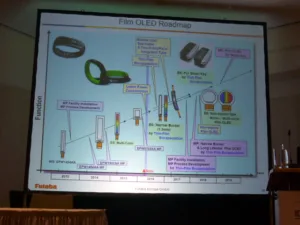Futaba’s Burkhard Jaeger discussed the expansion of the firm’s flexible PM-OLED range, which are produced for wearables. Futaba entered the OLED market after acquiring TMC in 2011.
Futaba PM OLED roadmap – Click for higher resolutionThe current focus is on small OLEDs, up to 2″. Futaba’s products are used in wearables from several tier 2 brands, such as Huawei, Razer and Garmin. They use a WOLED with a colour filter; colours do not shift over time, but a higher brightness is required than an RGB OLED. Futaba can drive its products at up to 700 cd/m².
Jaeger details some of the challenges of producing Futaba’s film-type OLEDs. They have a maximum operating temperature of 80° due to the plastic film substrate, and require gentle handling. They also do not – yet – meet the 10-year lifespan required for automotive and industrial applications.
Futaba is able to produce transparent PM-OLEDs, and has done previously on a Lenovo phone. Although this was a feature phone, it remains popular and sells for high prices to collectors on eBay. Jaeger said that Futaba learned a lot from producing this display – which only had 40% transparency and output about 60 lumens of brightness – and it can now reach about 70% transparency.

